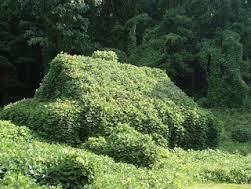 Normally I am plant lover kind of guy, but there is a group of foreigners that I love to hate. They are classed exotic invasive plants, and they are determined to take over the U.S. an acre at a time, disrupting native plants and ecosystems as they go. Probably the most notorious and recognized invasive plant in the south is Kuzdu (Pueraria montana). You don’t have to drive far to find its vines plastering the ground, trees, buildings and anything else standing in their way.
Normally I am plant lover kind of guy, but there is a group of foreigners that I love to hate. They are classed exotic invasive plants, and they are determined to take over the U.S. an acre at a time, disrupting native plants and ecosystems as they go. Probably the most notorious and recognized invasive plant in the south is Kuzdu (Pueraria montana). You don’t have to drive far to find its vines plastering the ground, trees, buildings and anything else standing in their way.
Like many invasive plants, kudzu was brought to the United States for positive reasons. It first appeared at the Philadelphia Centennial Exposition of 1876, where the Japanese government constructed a beautiful garden filled with plants from their country. The large leaves and sweet smelling blooms of kudzu caught the attention of American gardeners, who began to use the plant for ornamental purposes. Fast forward to the 1920s when a nursery grower in Florida found that animals would eat the plant and promoted it as a fast growing, high quality forage plant. Zip forward another 10 years to the Depression of the 1930s, when the Civil Conservation Corp employed armies of young men to do land conservation projects, that included the planting of many acres of kudzu on eroded hillsides and farms. In the 1940s a government conservation program actually paid farmers eight dollars an acre to plant fields of the vine. So you see, a lot of hard work went into creating this Frankenstein of the plant world, which was finally classified as a noxious weed by the USDA in 1972. Kudzu presently occupies over seven million acres of land in the southeast, and is gaining on us at the rate of 150,000 acres annually.
When native plants go head to head with Kudzu, even full grown trees, Kudzu wins every time. It is a highly efficient growing machine, with vines growing a foot per day and averaging 60 feet of growth per year. They can do this due to a number of advantages. The leaves are highly efficient solar collectors, and will actually track with the sun to maximize photosynthesis productivity. Also, they do not put a lot of energy into constructing a woody frame to support itself like most other plants. This allows kudzu to put more energy into vine growth and become a ‘structural parasite’, meaning they grow on top of other plants, power poles, and anything else to reach the sunlight. This fast growth and climbing ability allows it to quickly smother shrubs, trees, even entire forests and kill them through sunlight starvation. Over time kudzu can convert a healthy forest containing hundreds of plant and animal species and reduce it to an impoverished “vine barren” that contains only one species.
Control of kudzu is up hill work, and requires determination, patience, and money. If you mow it once a month during the growing season for two or three years, you might starve it out. Herbicides can work, but are expensive and repeat applications must be made for an average of four years to finally kill the root system out. Some cities and parks are using goats as lawn mowers to graze the plant to death, but again it’s a multi-year deal. Prescribed fire will not kill the root system, but can be used to remove the vegetative ground cover to allow access by control equipment. Several biological controls are being researched, and there is disease fungus called Myrothecium that is showing some promise.
If you have a kudzu problem on your property, it will only get worse. So if you possibly can, put your helmet on and go to war. For more information on controlling kudzu, contact your County Extension Agent, Natural Resources Conservation Service, or state forestry agency.

